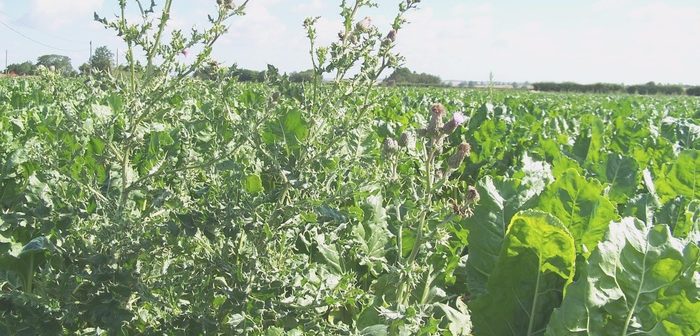Sugar beet has now been planted and is starting to grow away. This year the crop is showing a wide range of growth stages from 4 to 5 leaves to emerging plants at cotyledon stage. Sugar beet remains an important crop in the UK, supplying over half our sugar. It is an industry worth £865 million, employing 9,500 people and over 3,000 growers. To farmers sugar beet gives an opportunity to make a good gross margin, providing high yields are achieved, and to diversify away from cereals and rape. Most sugar beet is grown in the Eastern Region.
Effective weed control in the early growth stages of sugar beet is vital if high yields are to be achieved. The recent dry conditions means the pre-emergence herbicides may not have worked as well as hoped and the wide range of growth stages have made timings more of a challenge. In the first eight weeks of growth, sugar beet is uncompetitive; it is a slow growing crop, not closing in the rows for 12 to 14 weeks after planting. This slow growth allows weeds with a high biomass to establish and compete. High biomass weeds include volunteer potatoes, sow thistle, spear thistle and creeping thistle, all of which compete vigorously for water and nutrients, impeding crop growth, creating unwanted shade, blocking out sunlight and having a detrimental effect on yields. Research shows that 5 potato volunteers per square metre can result in yield loss of 16.5 t/ha of beet and they act as important sources of potato blight or Potato Cyst Nematodes (PCN). It is widely documented that one tall weed per square metre can cost 11% loss of yield. For the average crop this amounts to a loss of over 9 t/ha.
As with many crops, there are a lot of changes in the availability of products registered. This year growers are losing desmedipham and chloridazon. Other products have seen significant modifications in their labels such as limits over a 3 year period and loss of pre-em application timings, speak to your advisor for more details Agronomists must make sure they adhere to these restrictions and it is likely that more straight products will be tank mixed together, rather than coformulations, bringing an increased risk of crop damage.
Dow Shield 400 is a popular sugar beet herbicide choice as it controls the highly competitive tall biomass weeds that erode yields. “Growers who have had difficulties with timing and efficacy of pre-emergence herbicides can tidy up with Dow Shield 400. Growers should prioritise controlling tall weeds in sugar beet or be prepared to jeopardise yields,” according to Peter Waite, from Corteva.
Mr. Waite advises the use of the most effective herbicide early and often enough on the most competitive weeds, particularly those weeds that grow above the canopy. “Tall weeds must be dealt to make a significant difference to yields and gross margins. Dow Shield 400 is the most important herbicide for the reduction of volunteer potatoes in sugar beet. Sugar beet will always suffer potato volunteers as a potential weed problem, because there is a significant overlap between sugar beet and potato growing areas, and this year few potato volunteers will have been killed by frost because of the mild winter. Best control is achieved by making the first 0.25 L/ha application of Dow Shield 400 to emerging volunteer potatoes when they are 5-10 cms tall, followed by another application at 0.25 L/ha 7-10 days later,” says Peter.
Thistles also need targeting. Their dense stands of tall sappy stems compete directly with the sugar beet early on and left uncontrolled they also interfere with harvest. “Thistles grow to over 90 cms tall and have an extensive rooting system. Creeping thistles, spear thistles and sowthistles are all controlled by Dow Shield 400 at 0.25 L/ha applied to weeds at rosette stage followed by an application of 0.5 L/ha 3-4 weeks later to complete creeping thistle control. The first spray can be combined with a programme containing metamitron; this not only controls thistles but also boosts the performance of your programme against key annual weeds such as polygonums. In addition Dow Shield 400 will control corn marigold, groundsel, pineapple weed, scented mayweed, scentless mayweed, black-bindweed, pale persicaria and redshank. Its weed spectrum is a lot wider than many realise.”
Dow Shield 400 is a double strength formulation containing 400 g/litre and is available in a bottle container with no induction seal or foil to get rid of. “This self-seal technology means improved turn arounds, simplified waste recovery and reduced point source contamination. A familiar product on farms, Dow Shield has been available to growers for over 40 years. Growers need to think about their weed priorities in sugar beet and formulate their weed control strategies in the field. Dow Shield 400 should feature in most plans” concludes Mr Waite.





